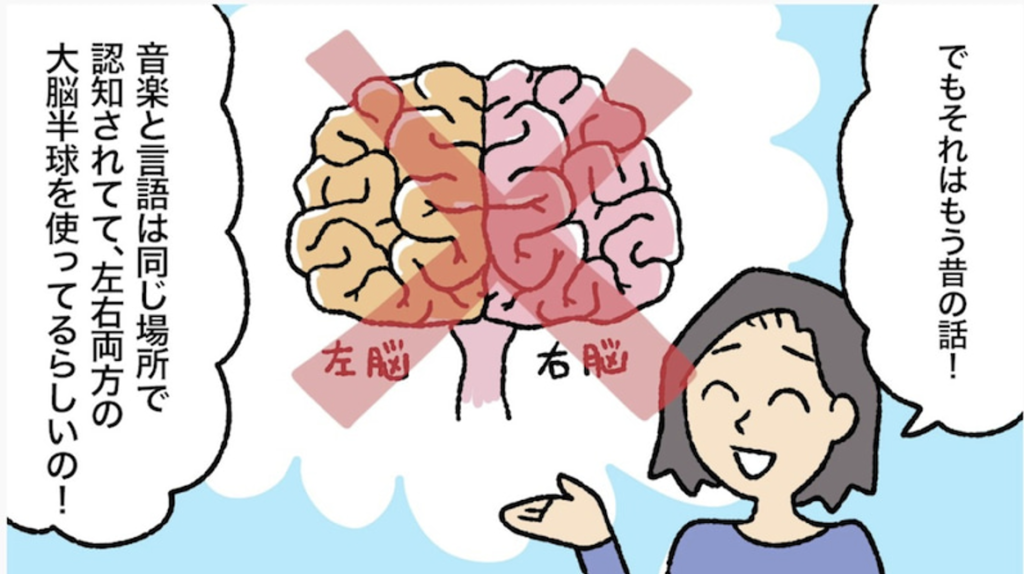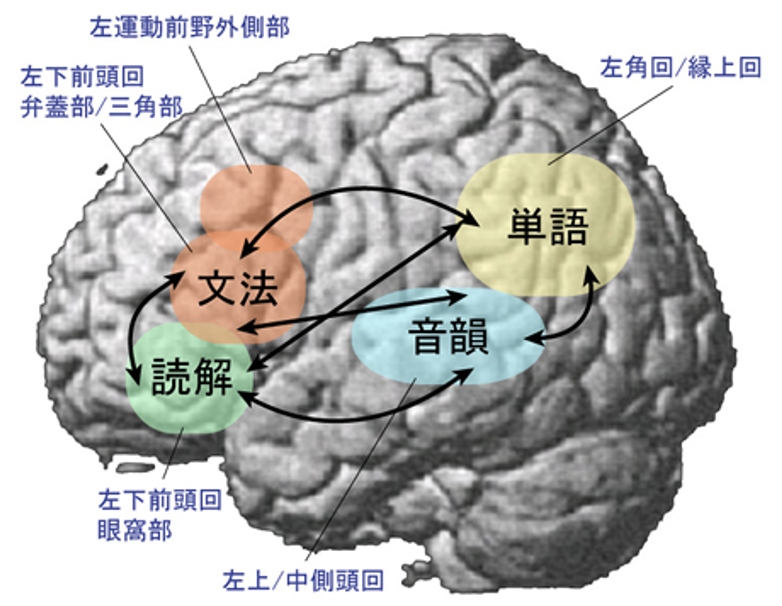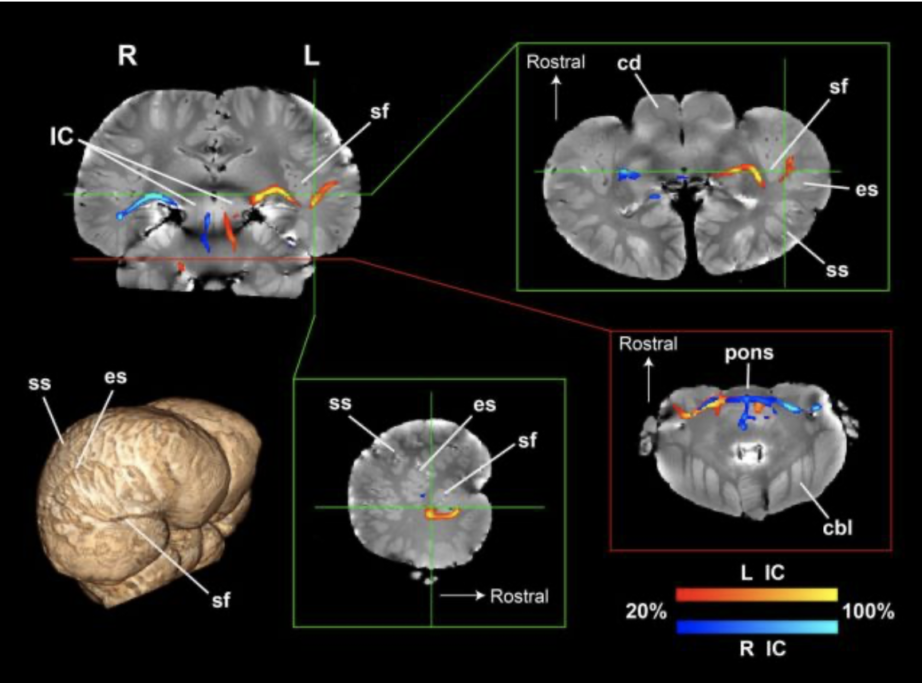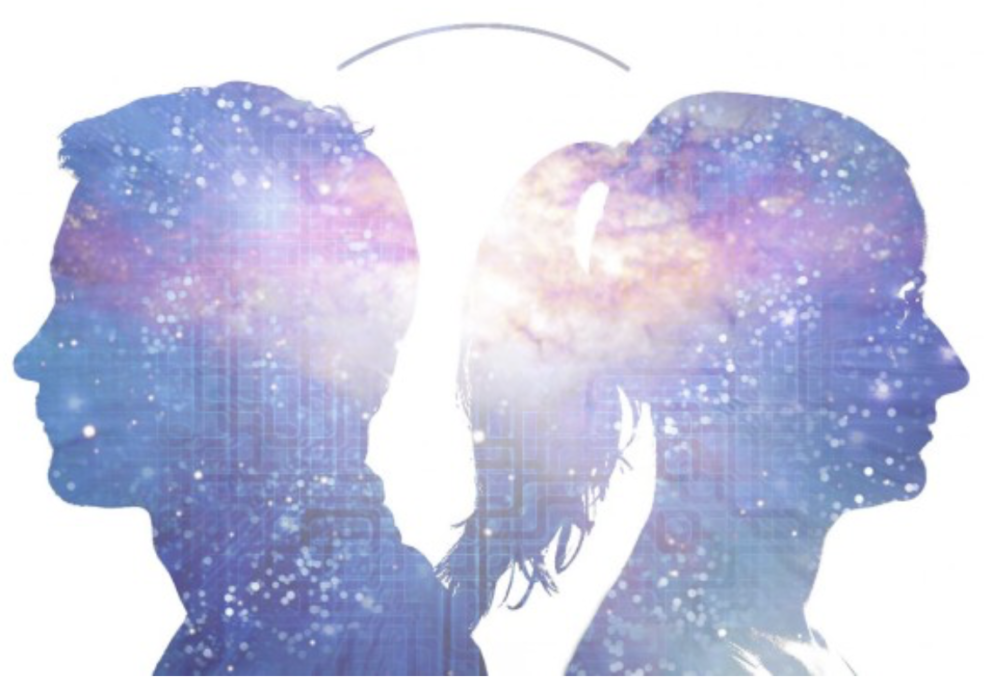はじめに
TED動画を見ていて、言語がテーマな動画が気になった。脳や言語に興味のある方はぜひ視聴してみてほしいと思う。
(出典:YouTube)
言語とは
右脳と左脳
良く言われるのは、右脳は感覚、左脳は思考とか、右脳はイメージ、左脳は論理など。しかし、最近の研究では、音楽と言語は同じ場所で認知されていて、左右両方の大脳半球を使用していることが確認されている。また、言語よりも音楽の方が脳を広範囲で利用しているという。言語と音楽の関係も興味深いテーマだ。
 (出典:ameblo)
(出典:ameblo)
言語の基本メカニズム
脳には、文法中枢や文章理解中枢、単語中枢、音韻中枢などあることが最近の研究で判明している。言語学では、文法処理が言語理解の核心であり、脳の文法中枢は「言語のエンジン」といえる。

(出典:ist)
イルカは言語を使えるのか?
この動画を視聴した後のディスカッションにおいて、イルカは言語を使えないというコメントと、イルカは言語を使えているけど人間がそれを理解できないだけというコメントに別れて激しい論争が繰り広げられていた。調べると、イルカは動物が持つソナー能力の中で一番洗練された能力を持っていて、イルカは素早く視覚と聴覚を切り替えることができることが分かってきている。さまざまなイルカの脳をスキャンしたところ、聴覚と視覚を担当している部位がはっきりと聴神経でつながってりることがわかった。今後の研究成果が待たれる。
(出典:GIZMODE)
猿は言語を使えるのか?
人間は言語など高度な認知機能を担う新皮質が発達した。その機能を担う遺伝子がARHGA11Bだ。この遺伝子を猿の胎児に移植したところ、ホモサピエンスの脳がたどった進化のように、移植から101日後には通常の脳よりも新皮質が大きく、人間のようなシワができた(出典)。生物倫理面の問題などはないのかを含めて、これもその後の動向が気になる研究だ。
犬は言語を使えるのか?
犬の脳にも左脳と右脳があり、役割分担というか左右差が確認されている。それは、人の幸せな声は左脳で識別し、悲しみや恐怖の声は右脳で処理されているという。犬は人が抱く感情を匂いから感じ取れる動物であり、感情に寄り添った思考ができるということのようだ(出典)。
なぜ人間だけが言語を使えるのか?
ヒトは昔はテレパシーを使えたのか?
昔のヒトはテレパシーの能力があったが、現代人はその機能が退化しているという指摘があるけど、これは本当なのだろうかフィリピンの超心理学者ハイメ・T・リカウコ博士によると、実験に協力的でテレパシーに対して偏見がない人が2人いれば再現可能なのだという。そして、最も上手にテレパシーが働くのは、感情的に相性の良い人同士だという。穏やかな状態で脳からα波が出ている状態で発言しやすい。テレパシーは距離の制限を受けないという。本当なのだろうか。
 (出典:parapaia)
(出典:parapaia)
右脳と左脳の役割分担との関連の可能性
これは個人的に関心を持っている仮説であり、人間の脳が右脳と左脳で機能分化が進んだ結果、右脳の思考を左脳が理解し、左脳の思考を右脳が理解する必要がある。そこで生じたのが言語ではないか。ただ、このような仮説を唱えている人はなかなかいない。もう少し調べてみようと思う。
8つの質問
Q1) In evolutionary terms, which animal is closest to humans?
動画の中でボノボとチンパンジが人間に近いと説明していたので、「Bonobo and chimpanzees are equally close」か。
Q2) The bonobo Kanzi shows language-like ability in
カンジと名づけられたボノボは、キーボードのシンボルを指差ししていたので、「Pointing to symbols on a keyboard」か。
Q3) Roughly how many different languages are there?
人類が使っている言語は、現在7,000種類ほどらしい。
Q4) The Pleistocene refers to which period?
更新世(Pleistocene)とは地質時代の区分の一つで、約258万年前から約1万年前までの期間だ。洪積世(Diluvium)とも呼ばれ、ほぼ氷河時代だ。選択肢の中では、「About 2-3 million to about 12,000 years ago」か。
Q5) Which of the following characteristics of our forebears did NOT emerge during the Pleistocene
更新世の時代に我々の祖先がしなかったことは書く(writing)ことだ。
Q6) In what ways does language differ from other forms of communication between animals?
人の言語は、他の動物間のコミュニケーションとどのような点で異なるのかといえば、言語は複雑な思考、知覚、運動機能と密接に関係するが、動物のコミュニケーションは、ほぼジェスチャーのレベルに限定されるので、英語では次のような感じか。
Q7) What kinds of evidence support the idea that language evolved from manual gestures?
言語が身振り手振りから進化した根拠は何かと聞かれてもこれは難しい。生物は生き残るために互いにコミュニケーションをとる必要があり、多くの動物は身振り手振りに限定されるが、人間は約7,000種類の言語を話します。どのように進化してきたかは謎ですが、声道を使って話すことができるのは人間だけなので、そんなことを英語で言えば、次のような感じか。
Q8) Does human thought depend on language? Can we have thought without language?
人間の思考は言語に依存しているか、言語がなくても思考はできるのかという質問だが、個人的には、人間は言語を使って思考していると考えるので、英語だと次のような感じだろうか。
まとめ
ちょっと今回はテーマが壮大で、それを裏付けるネタはまだまだ不十分だ。しかし、猿の退治に言語を担う遺伝子を移植するなどの実験で大脳皮質の発達が見られるなど、神をもおそれぬ所業と非難されそうな研究も進んでいる。人間が言語を使えるようになったのは、喉の構造的な進化や、脳の発達、より詳細なコミュニケーションの必要性などの複合的な要因が重なったのだと思うけど、今後の研究の成果に期待が集まる。楽しみな分野だ。
以上
最後まで読んで頂きありがとうございます。
拝
参考:英文スクリプト
In the 1980s, a bonobo named Kanzi learned to communicate with humans to an unprecedented extent – not through speech or gestures but using a keyboard of abstract symbols representing objects and actions.
By pointing to several of these in order, he created sequences to make requests, answer verbal questions from human researchers, and refer to objects that weren’t physically present. Kanzi’s exploits ignited immediate controversy over one question: had Kanzi learned language?
What we call language is something more specific than communication. Language is about sharing what’s in our minds: stories, opinions, questions, the past or future, imagined times or places, ideas. It is fundamentally open-ended and can be used to say an unlimited number of things. Many researchers are convinced that only humans have language, that the calls and gestures other species use to communicate are not languages.
Each of these calls and gestures generally corresponds to a specific message, for a limited total number of messages that aren’t combined into more complex ideas. For example, a monkey species might have a specific warning call that corresponds to a particular predator, like a snake – but with language, there are countless ways to say “watch out for the snake”.
So far no animal communication seems to have the open-mindedness of human language. We don’t know for sure what’s going on in animals’ heads, and it’s possible this definition of language, or our ways of measuring it, don’t apply to them. But as far as we know, only humans have language.
And while humans speak around 7,000 distinct languages, any child can learn any language, indicating that the biological machinery underlying language is common to all of us. So what does language mean for humanity?
What does it allow us to do, and how did we come to have it? Exactly when we acquired this capacity is still an open question. Chimps and bonobos are our closest living relatives, but the lineage leading to humans split from the other great apes more than four million years ago. In between, there were many species – all of them now extinct, which makes it very difficult to know if they had language or anything like it.
Great apes five one potential clue to the origins of language, though: it may have started as a gesture rather than speech. Great apes gesture to each other in the wild much more freely. Then they localize. Language may have begun to take shape during the Pleistocene, 2 to 3 million years ago, with the emergence of ah the genus homo, which eventually gave rise to our own species homo sapiens.
Brain size tripled, and bipedalism freed the hands for communication. There may have been a transition from gestural communication to gestural language – from pointing to objects and pantomiming actions – to more efficient, abstract signing. The abstraction of gestural communication would have removed the need for visuals, setting the stage for a transition to spoken language. That transition would have likely come later, though. Articulate speech depends on a vocal tract of a particular shape. Even our closest ancestors, the Neanderthals, and divisions had vocal tracts that were not optimal, and possibly even language.
Only in humans is the vocal tract optimal. Spoken words free the hands for activities such as tool use and transport. So it may have been the emergence of speech, not of language itself, that led to the dominance of our species. Language is so intimately tied to complex thought, perception, and motor functions that it’s difficult to untangle its biological origins. Some of the biggest mysteries remain: to what extent did language as a capacity shape humanity, and to what extent did humanity and shape language? What came first, is the vast number of possible scenarios we can envisage.




